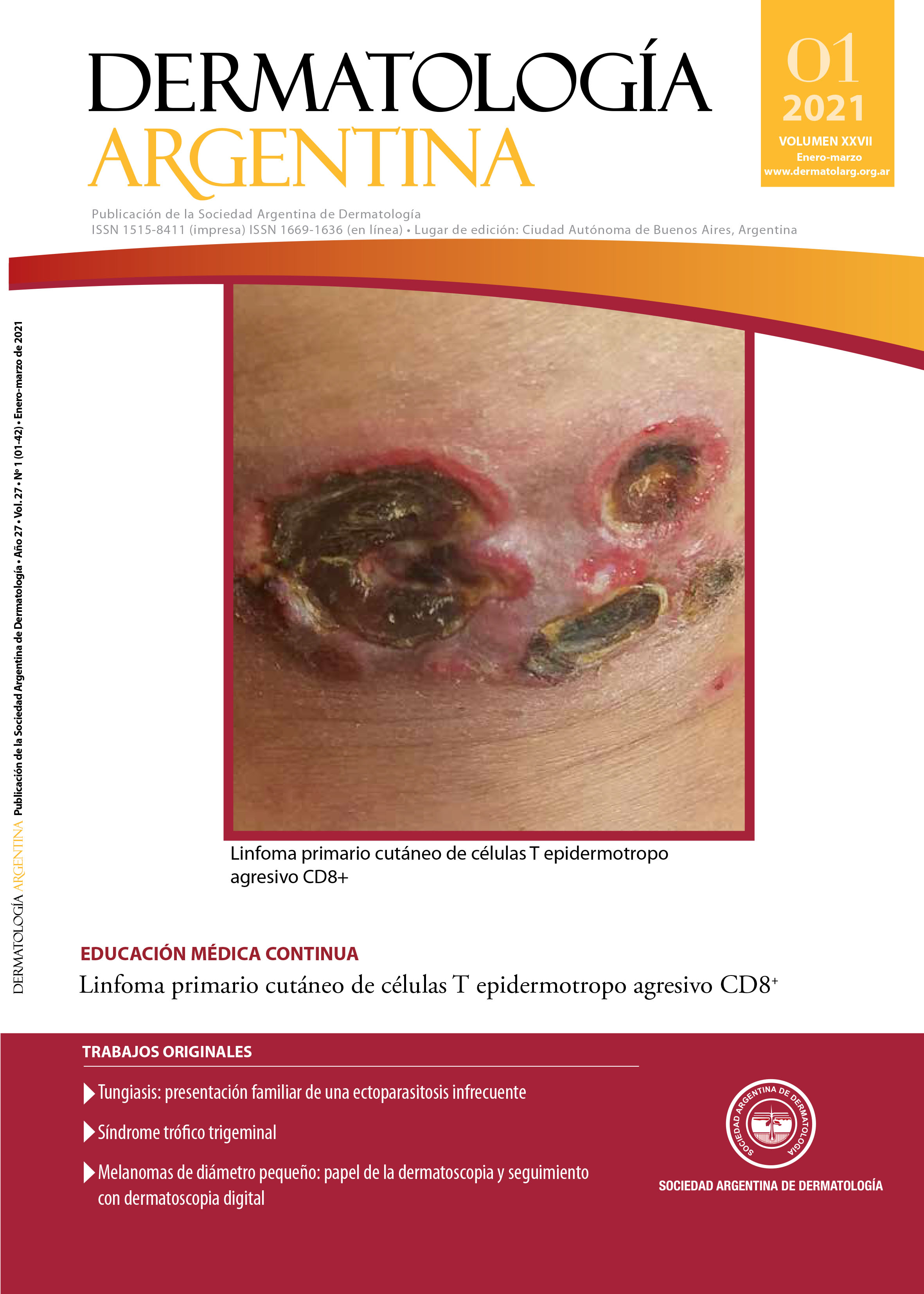Progressive macular hypomelanosis: response to treatment with minocycline
DOI:
https://doi.org/10.47196/da.v25i1.2199Keywords:
progressive macular hypomelanosis, C. acnes, tetracyclines, minocycline, Wood’s lightAbstract
Progressive macular hypomelanosis (PMH) is a dermatosis characterized by hypopigmented macules, most frequently found in females and in phototypes III and IV. Cutibacterium acnes (C. acnes) type III has been associated as an etiological factor.
We present the case of a thirty-year-old female patient with a 10-year history of nummular hypopigmented macules located on the top of the lower limbs and on the trunk. The histological study reported a decrease in the number of melanocytes and melanotic pigment in the basal layer and the presence of superficial perivascular mononuclear inflammatory infiltrate. After an 8-month regimen of oral minocycline 100 mg/day, there was a complete resolution of the lesions.
References
I. Santos JB, Almeida OL, Da Silva ML, Barreto ER. Efficacy of topical combination of benzoyl peroxide 5% and clindamycin 1% for the treatment of progressive macular hypomelanosis: a randomized, double-blind, placebo-controlled trial. An Bras Dermatol 2011;86:0-54.
II. Saleem MD, Oussedik E, Picardo M, Schoch JJ. Acquired disorders with hypopigmentation: A clinical approach to diagnosis and treatment. J Am Acad Dermatol 2019;80:1233-1250.
III. Petersen RLW, Scholz CFP, Jensen A, Brüggemann H, et ál. Propionibacterium Acnes phylogenetic type III is associated with progressive macular hypomelanosis. Eur J Microbiol Immunol 2017;7:37-45.
IV. Westerhof W, Relyveld GN, Kingswijk M, Man P, et ál. Propionibacterium acnes and the pathogenesis of progressive macular hypomelanosis. Arch Dermatol 2004;140:210-214.
V. Corvec S, Dagnelie MA, Khammari A, Dréno B. Taxonomy and phylogeny of Cutibacterium (formerly Propionibacterium) acnes in inflammatory skin diseases. Ann Dermatol Venereol 2019;146:26-30.
VI. Barnard E, Liu J, Yankova E, Cavalcanti SM, et ál. Strains of the Propionibacterium acnes type III lineage are associated with the skin condition progressive macular hypomelanosis. Sci Rep 2016;6:1-9.
VII. McDowell A, McLaughlin J, Layton AM. Is Cutibacterium (previously Propionibacterium) acnes a potential pathogenic factor in the aetiology of the skin disease progressive macular hypomelanosis? J Eur Acad Dermatol Venereol 2021;35:338-344.
VIII. Pflederer RT, Wuennenberg JP, Foote C, Aires D. Use of Wood’s lamp to diagnose progressive macular hypomelanosis. J Am Acad Dermatol 2017;77:e99-e100.
IX. Barnard E, Johson T, Ngo T, Arora U, et ál. Porphyrin production and regulation in cutaneous Propionibacteria. mSphere 2020;5:e00793-19.
X. Kim MB, Kim GW, Cho HH, Park HJ, et ál. Narrowband UVB treatment of progressive macular hypomelanosis. J Am Acad Dermatol 2012;66:598-605.
Downloads
Published
Issue
Section
License
El/los autor/es tranfieren todos los derechos de autor del manuscrito arriba mencionado a Dermatología Argentina en el caso de que el trabajo sea publicado. El/los autor/es declaran que el artículo es original, que no infringe ningún derecho de propiedad intelectual u otros derechos de terceros, que no se encuentra bajo consideración de otra revista y que no ha sido previamente publicado.
Le solicitamos haga click aquí para imprimir, firmar y enviar por correo postal la transferencia de los derechos de autor












